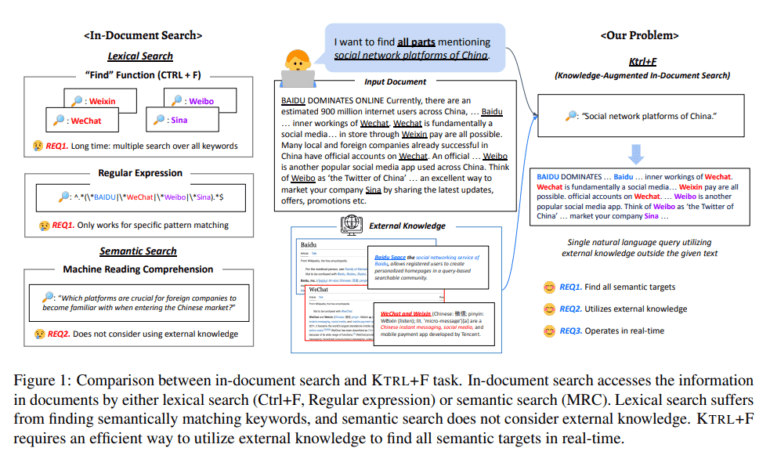TL;DR:
- KTRL+F is a game-changing innovation in in-document search by KAIST AI researchers.
- It introduces a Knowledge-Augmented Phrase Retrieval model for real-time semantic target identification.
- The model strikes a balance between speed and performance by incorporating external knowledge.
- KTRL+F focuses on enhancing information access efficiency through improved in-document search capabilities.
- User studies confirm its effectiveness in reducing search time and query complexity.
- Future research directions include end-to-end trainable architectures and the incorporation of timely knowledge sources.
Main AI News:
In the ever-evolving landscape of artificial intelligence, KAIST AI researchers have unveiled a groundbreaking innovation that promises to revolutionize in-document search – KTRL+F. This knowledge-augmented in-document search task demands real-time identification of semantic targets within a document, introducing a paradigm shift in the way we access information.
The Challenge
Traditional in-document search methods have long grappled with issues like hallucinations, sluggish response times, and the inability to harness superficial knowledge effectively. Enter KTRL+F, a pioneering solution co-crafted by the brilliant minds at KAIST AI and Samsung Research. It’s not just a search tool; it’s a game-changer.
The Solution
KTRL+F introduces the Knowledge-Augmented Phrase Retrieval model, meticulously designed to strike the perfect balance between speed and performance. Unlike conventional Machine Reading Comprehension tasks, this model goes beyond the confines of the provided context, harnessing external knowledge through a single natural query. It elevates contextual understanding, facilitating accurate and comprehensive search and retrieval within documents, thus enhancing information access.
Real-Time Semantic Target Identification
KTRL+F addresses the limitations of traditional lexical matching tools and machine reading comprehension. Its primary focus? Identifying semantic targets within a document in real time, while seamlessly incorporating external knowledge through a single, user-friendly query. Evaluation metrics scrutinize the model’s prowess in finding semantic marks, utilizing external commands, and delivering results in real-time. The ultimate goal? Boosting information access efficiency through superior in-document search capabilities.
A Multifaceted Approach
To achieve this, KTRL+F employs a multifaceted approach. It deftly balances speed and performance by embedding external knowledge into phrase embeddings. Various baseline models, including generative, extractive, and retrieval-based ones, undergo rigorous analysis using metrics like List EM, List Overlap F1, and Robustness Score. The integration of external knowledge is closely examined, and a user study unequivocally validates the transformative search experience enabled by KTRL+F.
The Power of Balance
While generative baselines effectively harness pre-trained language models, the scalability of their performance improvements is inconsistent. On the other hand, extractive baselines, like SequenceTagger, face challenges due to their inability to leverage external knowledge. KTRL+F, with its unique approach, strikes a harmonious balance between speed and performance by augmenting superficial knowledge embedding in phrase embedding. User feedback corroborates the model’s efficiency in reducing search time and query complexity, underlining its efficacy in elevating the search experience.
A Glimpse into the Future
KTRL+F ushers in a new era of knowledge-augmented in-document search tasks, showcasing the Knowledge-Augmented Phrase Retrieval model as a beacon of innovation. Its ability to seamlessly merge external knowledge with document context opens up exciting possibilities for the future of information retrieval and knowledge augmentation.
Looking ahead, the research community can explore end-to-end trainable architectures for real-time processing, enabling the integration of external knowledge into a searchable index. The expansion of KTRL+F to incorporate timely knowledge sources, such as news, and a deeper investigation into the importance of high-quality superficial knowledge through comparisons with different entity linkers, present promising avenues. Furthermore, continued evaluation of the knowledge aggregation design within the proposed model and extensive experimentation to understand baseline models and their limitations in the KTRL+F framework are strongly recommended. The future is bright, and KTRL+F is leading the way.
Conclusion:
The introduction of KTRL+F represents a significant advancement in the field of in-document search. Its ability to seamlessly integrate external knowledge into a document context and improve search efficiency has the potential to disrupt the market. Businesses that rely on quick and accurate information retrieval stand to benefit from KTRL+F’s capabilities. As organizations seek to optimize their information access, KTRL+F offers a promising solution that can shape the future of the market.

